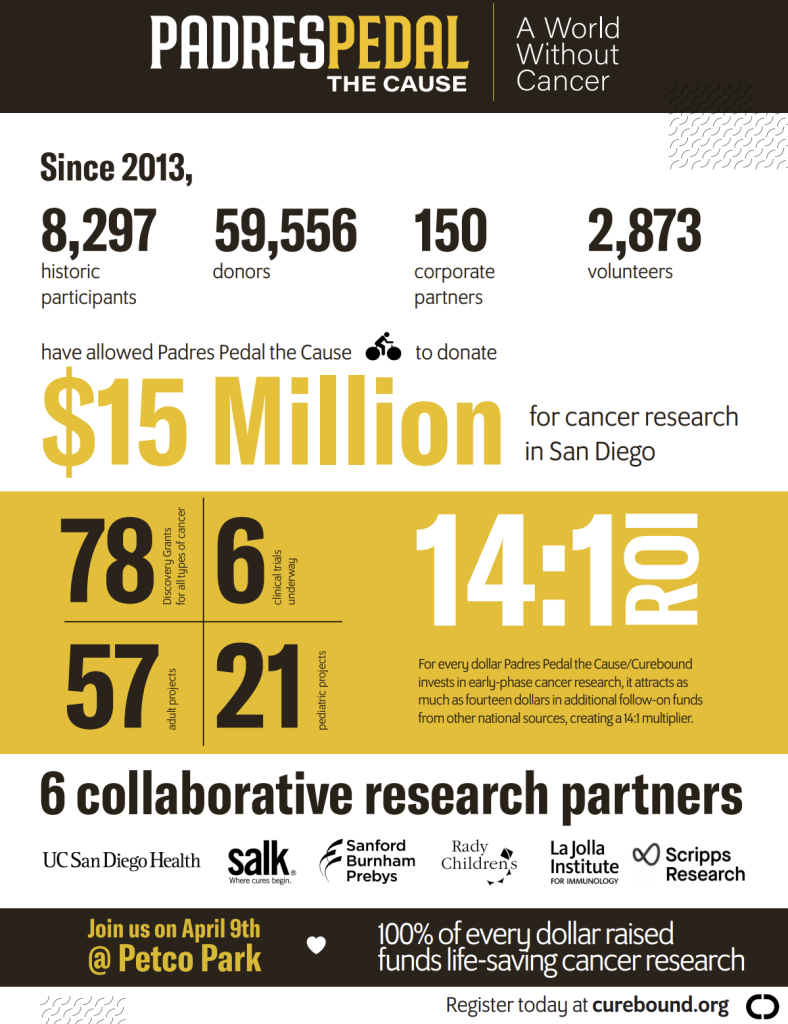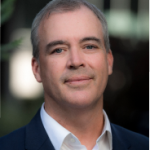As a nonprofit, San Diego Regional EDC is supported by investment from nearly 200 private organizations, companies, and public agencies. With their support, EDC provides direct services to help companies grow and thrive in San Diego, and leads initiatives to enhance the region’s recovery and resilience.
We sat down with EDC investor Anne Marbarger, CEO of Curebound, to discuss its mission to accelerate cures for cancer in our lifetime and realize a world without cancer from San Diego. Check it out!

Tell us about Curebound and its mission.
Launched in 2021, Curebound is an evolution and expansion of two highly respected cancer organizations, Padres Pedal the Cause and the Immunotherapy Foundation, which have come together to help create a robust, sustainable source of funding for cancer research and to broaden awareness, education, and outreach across San Diego. To date, we have donated $20 million to fund 78 innovative research projects, including six clinical trials.
Our mission is to mobilize San Diego to accelerate cures for cancer in our lifetime. To help realize our vision of a world without cancer, Curebound is committed to investing $100 million into collaborative cancer research over the next decade and making San Diego a global center of cancer research and cures.
Why San Diego?
Curebound is headquartered in San Diego amidst a unique combination of three National Cancer Institute cancer centers, clinical care hospitals, biotech companies, venture capital investors, philanthropic networks, and, most importantly, a regional culture that embraces the spirit of collaboration. This ecosystem positions San Diego and Curebound at the forefront of discovery—bringing genomic medicine, new technologies, and clinical trials to market and presents an unprecedented opportunity for research collaboration.
Curebound is a catalyst that brings these resources together to accelerate cures. We are proud to partner with the top cancer research institutions in San Diego, including Moores Cancer Center at UC San Diego Health, Rady Children’s Hospital, Salk Institute, Sanford Burnham Prebys, La Jolla Institute for Immunology, and Scripps Research. We see that San Diego has enormous potential to become a “cancer-curing city” and that the next decade will be critical in the development of sophisticated, personalized approaches in the way we prevent, treat, and ultimately find cures for cancer.
How can San Diegans get involved?
Padres Pedal the Cause is Curebound’s signature community event on April 9 at Petco Park. After two and a half years of virtual events due to the pandemic, we are excited to be back in person and look forward to celebrating with our cancer-fighting community of survivors, friends, families, doctors, scientists, and volunteers. One hundred percent of every dollar raised funds life-saving cancer research in San Diego.
The event features cycling courses for all abilities that ride out over the beautiful Coronado Bridge and finish at Petco Park, the option to run or walk a new and improved 5K through downtown San Diego, and a rooftop spin class atop the historic Western Metal Supply Co. building with fun, inspirational rides from some of San Diego’s most popular instructors.
This year, we are encouraging our local businesses to take part in our Corporate Challenge. The Corporate Challenge is an opportunity to come together as a company in support of family members and friends whose lives have been changed by cancer. It’s a great way to bring your workforce together with a positive focus on health and wellness, community engagement, and strong internal team building.

Tell us about your involvement with San Diego Regional EDC and its team.
Curebound is proud to invest in the fantastic work being done by EDC. We all feel very fortunate and appreciate the opportunity to partner with CEO Mark Cafferty and the EDC team, along with so many exceptional business leaders across San Diego.
EDC has done so much to advance and empower San Diego for many years and we believe Curebound aligns with EDC’s vision in many ways. For example, Advancing San Diego‘s collaborative effort to align economic development and workforce development around a common set of goals is truly impressive and speaks to the heart of our own core values of community, collaboration, and cures. Thank you all!
Looking ahead, what is on the horizon for your organization?
Our mission, vision, hope, and dream is to accelerate cures in our lifetime, so that the next generation doesn’t have to experience a cancer diagnosis in the frightening way that too many of us do now. We will continue to increase and expand our outreach and opportunities for community engagement as we grow with new events and programs on the horizon. There is much in the works and we’re excited to share more in the coming months.
In the meantime, we hope you’ll join us for Padres Pedal the Cause in April and look for more information coming soon for our next series of events in honor of World Without Cancer Day on June 20.
Learn more: curebound.org
Twitter: @PedalSD
Read more about EDC’s investors in our investor spotlight blog series. Or, join Curebound by becoming a member of EDC.



